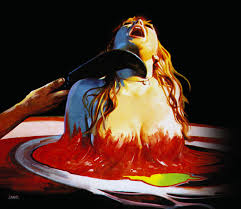Of all the American directors who came to prominence in the 1970s, Robert Altman is the warmest, the most democratic and the most disarming. The overlapping dialogue, shaggy plots, lived-in sets, and sharp characterization make nearly all of his films feel both like “slices of life” and something much more personal and unique — it’s just that the lives being portrayed are themselves theatrical and all over the place.
October 2014
Kaneto Shindo was a remarkably prolific writer and director who dabbled in numerous genres. His horror Kuroneko (full translation of the original title: “Black Cat from the Grove”) is a surprising, eerie film, shot in haunted black and white by frequent collaborator Kiyomi Kuroda, that draws together elements of Japanese folklore and period setting with very modern sensibilities – a disdain for authority and tradition, a Freudian uncanniness, a clear attention to the plight of “commoners,” and a feminist edge.
Bay of Blood (aka Twitch of the Death Nerve), Mario Bava’s 1971 giallo-trending-towards-slasher flick, is reportedly the goriest of all his films (definitely the goriest of those I’ve seen), and widely considered a major influence on many films to follow a decade later.
The Dissolve commentariat has been posting write-ups of horror movies all month (which are amazing and which you should read). Here’s mine, on Val Lewton.
SCAREFEST: Val Lewton Marathon — Cat People (Jacques Tourneur, 1942); The Curse of the Cat People (Gunther von Fritsch, Robert Wise, 1944); The 7th Victim (Mark Robson, 1943)
The original Cat People – Val Lewton’s 1942 production debut for RKO, directed by Jacques Tourneur – is justifiably famous for the absence of, well, cat people.





